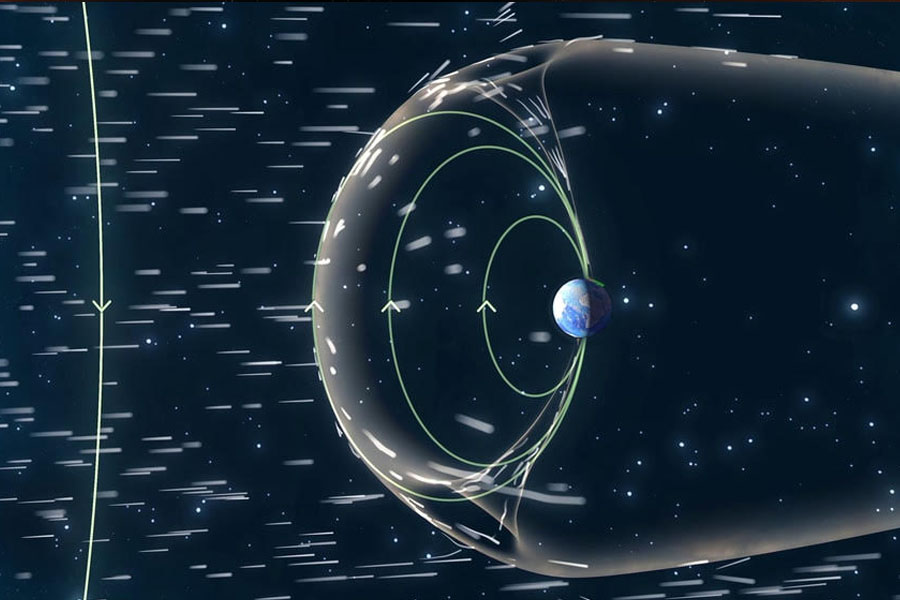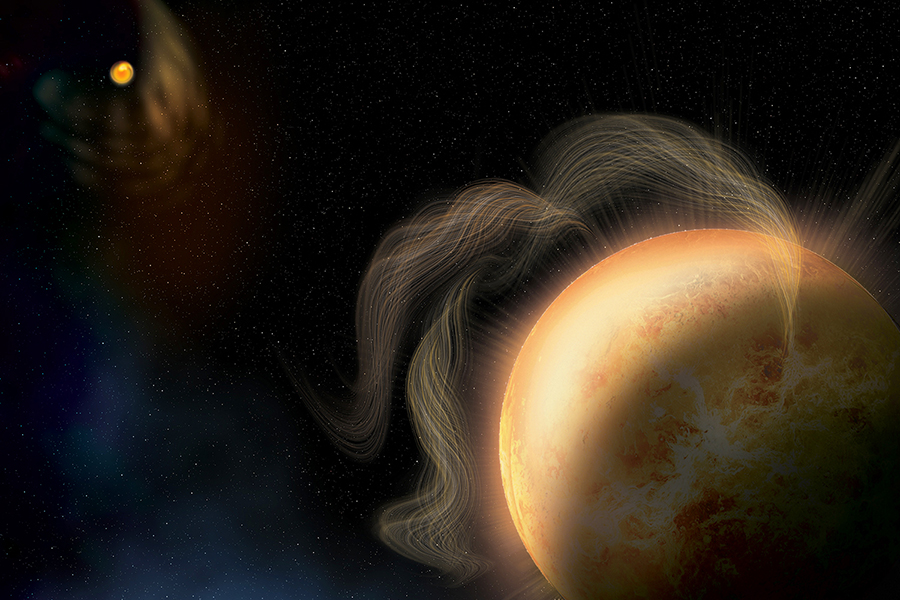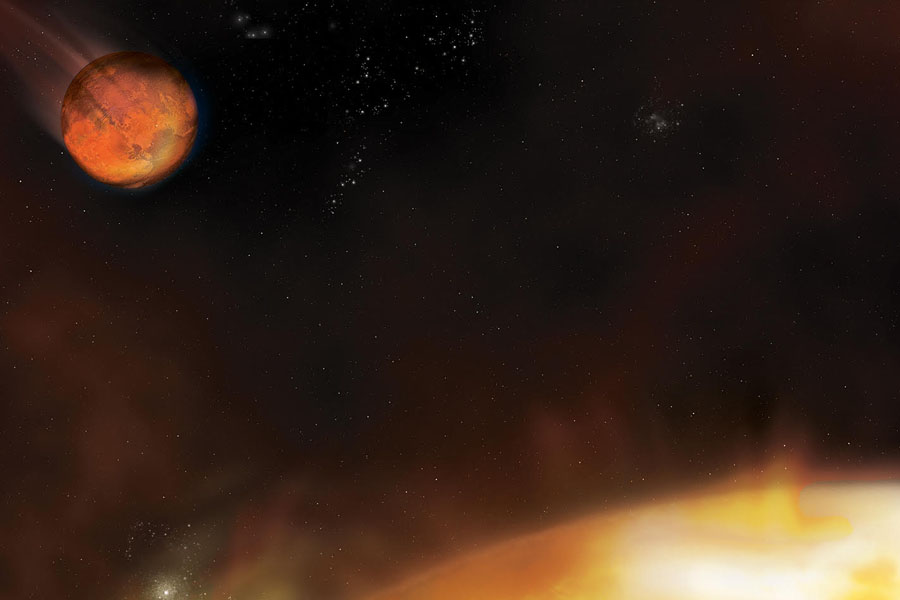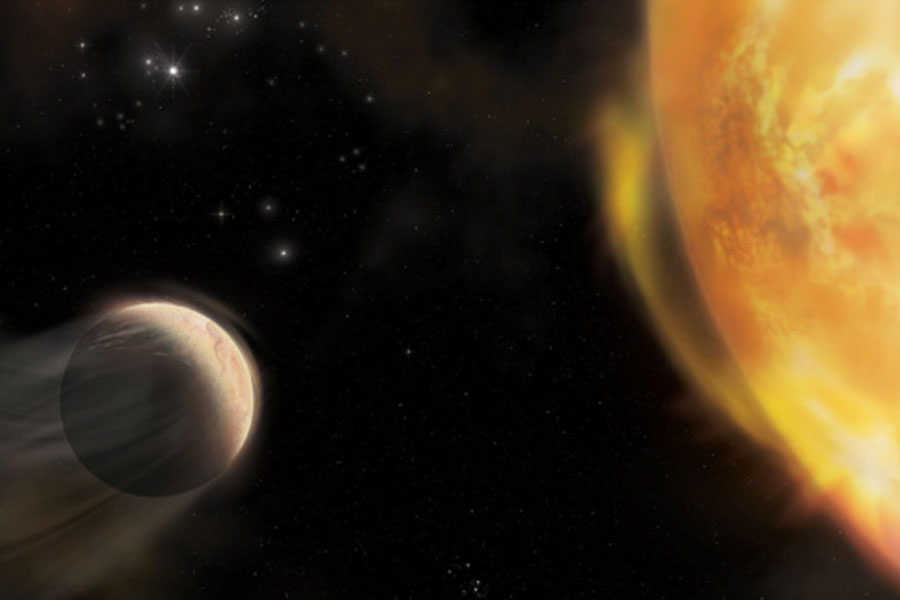For Everyone
MACH is devising a strategy to estimate how quickly different planets lose their atmosphere. There are many different kinds of planets, and many different kinds of stars. Topics which connect our everyday lives to MACH’s mission are discussed in many ways around the world. Below are some of our favorites.

Monarch Butterflies use Magnetic Fields to Navigate
Featured on the “Wonders of Life” BBC program with Brian Cox, this video takes the viewer three hours Northwest of Mexico City, where one of the few remaining wintering grounds for Monarch Butterflies is located. Brian Cox teaches us about the ways that these butterflies supplement their navigation by using measurements of the position of the sun taken each day with their eyes and magnetic sense.

Trees Show When the Earth’s Magnetic Field Last Flipped Out
42,000 years ago, the North Pole “wandered around.” By looking at giant Kauri trees in New
Zealand, a
research team has found a way to study the historic movement of the pole.
Cooper and his team also found that the time of the wandering poles lines up with great changes to the climate, leading to the disappearance of neanderthals as well as many large mammals in Australia. It is even theorized that this influx of ionizing radiation and ultraviolet crashing into the Earth is what drove early humans into caves!

The Woman Who Mapped the Sun Over Time
Inside of the sun, trillions of hydrogen atoms fuse into helium atoms, a process called nuclear
fission. This ongoing explosion maintains the sun’s internal temperature of roughly 15 million
degrees Celsius, causing gas that is exposed to these temperatures to be turned into plasma. The
charged particles that make up plasma then produce powerful magnetic fields. This solar plasma
can
produce temporary concentrations of magnetic activity.
These concentrations of magnetic activity
will reduce heat in an area, producing less light and what looks like a dark spot on the surface
of
the sun. These dark spots are known as sun spots, and they are what Hisako Koyama tracked
diligently
over a period of many years.

Earth’s Leaky Atmosphere
Dough Rowland, a NASA scientist, brought his research team to the island of Svalbard, where the small town nearest to the North Pole sits, in order to study one of the places where 100 tons of atmosphere escapes into space each day. The leak is a natural process, and part of the way a planet’s atmosphere changes over time. This understanding of atmospheric escape is a key factor in the search for other planets that could sustain life, and it has been on the mind of researchers for four decades. Part of what Rowland’s team in the North Pole seeks to better understand is the nature of change in Earth’s atmosphere over time. How would other planets, that may be similar to Earth, experience changes in their atmosphere?

Venus and its ‘Electric Wind’
While Venus may be the most like Earth in terms of size and gravity, its surface temperatures sit around 860 F. There is evidence, however, that Venus once had oceans in the distant past. If oceans boiled away as a result of temperature, though, Venus would have much more water in its atmosphere than it does. In this story, Bill Steigerwald explores the concept of an electric wind on Venus that is likely to be responsible for removing the steam from the atmosphere, and much more.

Mars and its Vanishing Atmosphere
On NPR’s program All Things Considered, Mars’ drastic change from a “reasonably pleasant place” to the dry and barren land that it is today is explored. Citing data from MAVEN, researchers have found that the atmosphere on Mars continues to deteriorate today, due to the solar wind coming from the sun.

Studying the Atmospheres of Planets Too Far Away to be Imaged
This exemplary video from NASA Goddard explores the ways in which astronomers today study exoplanets that are too far away to be directly imaged. By “splitting apart” the light of the star that these planets orbit, astronomers are able to study the atmosphere of exoplanets.
Mentoring Undergraduates
“I applied to MACH SUR because I’m interested in all areas of astronomy related to planets, but I wasn’t sure how interesting a project about the Earth would be. I was pleasantly surprised by how much there is to learn about our home planet, and by how fascinating the science and research behind it is!”
The MACH center developed a Summer Undergraduate Research (SUR) program, leveraging the structure and offerings of LASP’s NSF-funded Boulder Solar Alliance Research Experience for Undergraduates (REU) program. The 2021 SUR program was an 8-week program in which students virtually participated in weekly professional development activities, including IDL programming tutorials and presentation rehearsals. The program was evaluated via weekly student journal entries and monthly mentor check-ins. The SUR 2021 and 2022 Programs trained and mentored 5 students in research methodologies, ion escape affected by space weather, planetary magnetic fields and EUV stellar outputs. The students were selected from over 40 student applicants, as the top of their peers in a number of criteria, including the following:
- Interest in space physics topics
- Career interest in science, engineering, or computer science
- Ability to work through challenges
- Lack of opportunities related to their career goals
- Upper level courses in science or coding to support research goals
- Programming experience
For the 2022 program, the following eligibility criteria were instigated: students must be starting their junior or senior years in the following academic year, a U.S. Citizen, and from a MACH Center University partner. (Partnering Universities: University of Colorado, Boulder, working in partnership with University of California, Los Angeles, University of Kansas, University of New Hampshire, and Sonoma State University. )
2022 SUR Program Presentations
Geomagnetic Storms and Ion Outflow
Aislyn Bell, Undergraduate at University of Colorado, Boulder
Mentor: Dr. Lynn Kistler, University of New Hampshire
Aislyn Bell’s research sought to answer the question, “How does ionospheric outflow vary with substorm phase and
method of identification?” Five lists of substorm onsets using both imaging and magnetometer methods of
identification were gathered. Using TEAMS data from the FAST spacecraft, a superposed epoch analysis was performed
on all of the lists from 1996/12/01-1997/02/28. This analysis was expanded through 1998/11/30 for three of the
substorm onset lists, and the superposed epoch analysis was performed again. These results showed an increase in ion
outflow at substorm onset, as was hypothesized.
Downloads: Presentation (.pptx) | Journal Entries
(.pdf)
Mercury’s Calcium Exosphere
William Solorio, Undergraduate at University of Colorado, Boulder
Mentor: Dr. Aimee Merkel and David Brain, University of Colorado, Boulder
William Solorio’s research focused on Mercury’s calcium exosphere and the main atmospheric loss processes that fuel
said exosphere. From MESSENGER UVVS data, there was an unexpected enhanced calcium emission about the dusk northern
cusp region of the planet, and so William used an updated exosphere model to see what atmospheric loss processes
could be responsible for that enhancement. William then compared the radiance/emission data of the calcium dawn
source model to a solar wind sputtering model and the UVVS data to see which of the two could explain the
enhancement. It turns out that with the current model, neither process seems to explain that observed enhancement.
Downloads: Presentation (.pptx) | Journal Entries
(.pdf)
2021 SUR Program Presentations
Geomagnetic Storms and Ion Outflow
Genevieve Katherine Payne
Genevieve Katherine Payne asked the question, “How do different types of geomagnetic storms change the
ion outflow from Earth?” To answer the question, first Genevieve gives a few brief descriptions of solar
storms, coronal mass ejections, stream interaction regions, and geomagnetic storms. Genevieve and her
team used data from the FAST satellite to observe a full solar cycle of 11 years. By using previously
existing times and dates of recorded coronal mass ejections and comparing them to the data obtained from
the satellite, Genevieve and her team were able to establish a clear correlation between the number of
CME and SIR events and the sunspot activity during their years.
Downloads: Presentation (.pptx) | Journal Entries (.docx)
Evidence of Currents During Atmospheric Escape on Mars and Their Locations
Jade Fitzgerald
Jade Fitzgerald’s research focused primarily on Mars and the waning of its magnetic field over time.
There are, however, various magnetic spots of crust, which can actually cause an occurrence of Aurora
Borealis, similar to that seen on Earth. Jade then asks, “Are these events significant to habitability?”
To answer this question, Jade used data from the Mars Global Surveyor, or MGS, from January 2001,
November 2003, and April 2005. As expected, there are stronger regions of the crust that have
concentrated magnetization.
Downloads: Presentation (.pptx)
Mars as an Exoplanet of an M Dwarf Star
Xinrun Du
Xinrun Du sought to answer the question, “How does the stellar wind of an M dwarf star affect the
atmospheric escape of a Mars-like planet?” Beginning with a brief explanation of the M dwarf stars,
which are the most abundant type of stars in our galaxy, Xinrun demonstrated why a planet orbiting an M
dwarf star would be more exposed to the stellar wind. Mars was chosen as a comparison planet because of
its complex magnetization, as well as the atmospheric loss over time which already has established data
to study.
Downloads: Presentation (.pptx)
About MACH Mentoring
“The time I spent participating in the MACH REU was both a great learning experience and a productive way to advance my experience with astronomical research. Everyone on the team was very kind and always helpful, making the working environment feel welcoming and open.”
Media
Do Habitable Worlds Require Magnetic Fields?
Prof. Dr. David Brain, Principal Investigator (PI) of the MACH Center, has presented to multiple audiences on the topic of whether habitable worlds require magnetic fields. He has thus far presented at the following events. If an event has a link, it is to the online recording of the talk.
- U. Heidelberg Joint Astronomical Colloquium, 16 November 2021
- Europlanet Science congress (EPSC), 07 September 2021
- Asia Oceania geosciences Society (AOGS), 06 August, 2021
- Boulder Solar Research Experiences for Undergraduates (REU) Program, 09 July, 2021
- Arizona State University School of Earth and Space Exploration (SESE) Colloquium, 10 March, 2021
- Laboratory for Atmospheric and Space Physics (LASP) Public Lecture, 03 Feb 2021
- Queen Mary University of London Astronomy Seminar, 06 November 2020
- University of Massachusetts (UMass) Lowell Physics Colloquium, September 16, 2020
- Goddard Space Flight Center (GSFC) Scientific Colloquium, March 04, 2020
- TedX Talk, December, 2020
Dome-to-Home Virtual Events
During COVID19 Restrictions in 2020 and 2021, MACH partnered with Fiske Planetarium and the Laboratory of Atmospheric and Space Physics (LASP) at the University of Colorado, Boulder, to share MACH science with the public in live events. These events were available for virtual attendance and can be viewed below.
Additional Resources
Fiske Planetarium Dome to Home: A science education series that is free and open to all audiences, but specifically geared toward 4th – 8th grade students. Science on a Sphere (SoS) Network Members: View a list of over 150 institutions globally have SOS displays with the capabilities of interacting with MACH SOS datasets.
